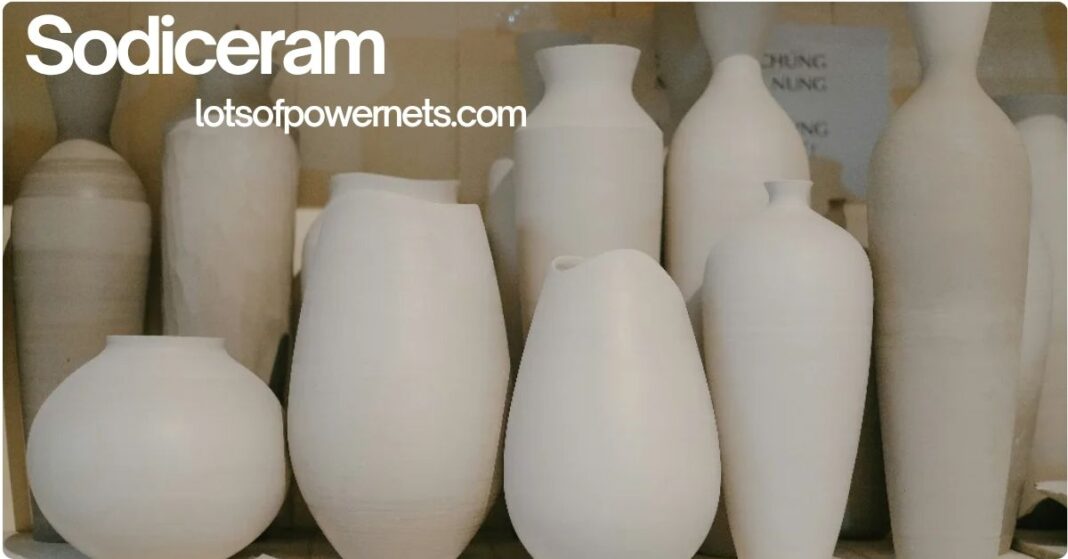In recent years, the world of advanced materials has seen significant breakthroughs. Among them, Sodiceram stands out as a game-changer in the field of engineering ceramics. This innovative material integrates sodium-based compounds, setting it apart from traditional ceramics. Sodiceram has been designed to meet the challenges of modern industries, offering superior performance in various applications. Whether in manufacturing, electronics, or other advanced sectors, Sodiceram is quickly becoming a material of choice due to its unique properties and capabilities.
What is Sodiceram?
Sodiceram is a type of advanced engineered ceramic that incorporates sodium-based compounds into its structure. Unlike traditional ceramics, which primarily rely on materials like alumina or silica, Sodiceram uses sodium compounds to enhance various aspects of the ceramic’s performance. This innovation makes Sodiceram an attractive alternative in many industrial applications.
The sodium-based compounds within Sodiceram contribute to its ability to withstand extreme temperatures, pressures, and aggressive chemical environments. Additionally, Sodiceram is known for its high strength, thermal conductivity, and electrical insulation properties. As a result, it is increasingly being utilized in industries where traditional ceramics fall short.

The Science Behind Sodiceram
The key to Sodiceram’s enhanced performance lies in its composition. The sodium-based compounds used in Sodiceram interact with the ceramic matrix, offering improved durability and resilience. These compounds influence the ceramic’s molecular structure, making it more resistant to wear, corrosion, and other environmental factors.
The combination of sodium-based compounds with traditional ceramic materials results in a unique microstructure that allows Sodiceram to exhibit several important characteristics, including:
Also Read: Contact RobTheCoins: How to Reach Out for Assistance
- Increased Durability: The sodium compounds help improve the ceramic’s resistance to abrasion, ensuring longer service life.
- Superior Heat Resistance: Sodiceram can withstand higher temperatures without compromising its structural integrity.
- Enhanced Chemical Resistance: The material is less prone to damage from acidic or corrosive environments, making it ideal for use in harsh conditions.
- Improved Mechanical Strength: Sodiceram offers higher tensile strength and toughness compared to traditional ceramics, enabling it to handle greater stresses.
Why Choose Sodiceram Over Traditional Ceramics?
Traditional ceramics have served numerous industries for centuries, but as technology and demands evolve, so must the materials we rely on. Sodiceram offers several advantages over conventional ceramic materials, which include:
1. Higher Performance in Extreme Conditions
Traditional ceramics often struggle in environments with extreme temperatures or aggressive chemicals. Sodiceram, on the other hand, is designed to thrive under such conditions. Its sodium-based compounds enable it to maintain structural integrity in high-temperature environments that would typically cause conventional ceramics to degrade.
2. Improved Durability and Longevity
Due to the presence of sodium compounds, Sodiceram is more resistant to wear and tear. It can endure longer operational cycles, reducing the need for frequent replacements, thus lowering maintenance costs for industrial applications.
3. Better Thermal Conductivity
One of the standout features of Sodiceram is its exceptional thermal conductivity. In applications where heat dissipation is crucial, Sodiceram can outperform traditional ceramics, making it suitable for industries like electronics and aerospace, where managing heat is a primary concern.
4. Enhanced Electrical Insulation Properties
Another advantage of Sodiceram is its electrical insulation properties. It provides an effective barrier against electrical currents, making it an ideal material for electronic components and high-voltage applications.
Applications of Sodiceram
As a versatile material, Sodiceram finds application across a wide range of industries. Here are some key sectors where Sodiceram is making a significant impact:
1. Electronics and Electrical Engineering
In the electronics industry, Sodiceram is used for making components that need to withstand high temperatures while providing electrical insulation. This includes semiconductors, capacitors, and insulators used in high-voltage systems. Its ability to offer superior thermal and electrical properties makes it a preferred choice in these applications.
Also Read: Blazertje: A Timeless Fashion Staple for Every Wardrobe
2. Aerospace and Defense
The aerospace industry demands materials that are not only durable but also able to handle extreme temperatures and pressures. Sodiceram is increasingly being used for various aerospace components, including heat shields, turbine blades, and engine components, due to its high thermal resistance and strength.
3. Manufacturing and Heavy Industry
In manufacturing processes where machinery is subjected to high stress and abrasive conditions, Sodiceram proves invaluable. It is used in wear-resistant parts such as seals, bearings, and valves, offering extended service life and reduced maintenance costs.
4. Automotive Industry
The automotive sector also benefits from Sodiceram’s properties. It is used in components that need to withstand high temperatures, such as exhaust systems and engine parts. Additionally, Sodiceram is utilized in advanced braking systems due to its ability to handle thermal cycling without degradation.
5. Medical Devices
In the medical field, Sodiceram is used in components that require high strength and resistance to chemical corrosion. Its application in medical devices like prosthetics, surgical instruments, and diagnostic tools ensures reliability and durability.
Benefits of Sodiceram in Industrial Applications
Sodiceram’s unique properties offer a wide range of benefits for industrial applications:
- Cost-Effectiveness: While Sodiceram may come with a higher upfront cost compared to traditional ceramics, its long lifespan and reduced maintenance costs provide excellent value over time.
- Reliability: With its high resistance to wear and heat, Sodiceram offers reliable performance, reducing the risk of failure in critical applications.
- Customization: Sodiceram can be tailored to specific requirements, allowing manufacturers to create custom shapes and sizes for specialized applications.
- Environmental Resistance: Sodiceram is designed to resist harsh chemicals, high temperatures, and mechanical stresses, making it suitable for extreme conditions.
Future Prospects of Sodiceram
The potential for Sodiceram is vast, and as research continues to uncover more about its properties, its applications will likely expand even further. The development of more advanced Sodiceram formulations could lead to improvements in its electrical conductivity, making it even more suitable for cutting-edge electronic applications.
Moreover, the increased demand for Sodiceram in industries such as renewable energy, where materials need to withstand high thermal loads and environmental factors, is expected to drive innovation in this space.
Also Read: Jhonbaby777: Expert Digital Marketing Services to Boost Your Online Presence
Challenges in Sodiceram Adoption
Despite its many benefits, there are some challenges to the widespread adoption of Sodiceram:
- Production Costs: The production of Sodiceram can be more expensive compared to traditional ceramics, making it less accessible for industries with tight budgets.
- Technological Limitations: While Sodiceram shows great promise, its use in highly specialized applications may still be limited by current manufacturing capabilities and technological constraints.
FAQs About Sodiceram
What is Sodiceram made of?
Sodiceram is primarily made from sodium-based compounds integrated with traditional ceramic materials. The addition of sodium enhances the ceramic’s resistance to heat, wear, and chemical degradation.
How does Sodiceram differ from traditional ceramics?
Unlike traditional ceramics, which are typically made from materials like alumina or silica, Sodiceram incorporates sodium compounds that enhance its durability, heat resistance, and mechanical strength.
What are the advantages of using Sodiceram?
The main advantages of Sodiceram include increased durability, better heat resistance, superior chemical resistance, and improved mechanical strength, making it ideal for harsh industrial conditions.
Where is Sodiceram used?
Sodiceram is used in a wide range of industries, including electronics, aerospace, automotive, manufacturing, and medical devices, due to its advanced properties that improve performance and reliability.
Is Sodiceram cost-effective?
While Sodiceram may have a higher initial cost compared to traditional ceramics, its longer lifespan and reduced maintenance costs make it a cost-effective solution in the long run.
Conclusion
Sodiceram represents a significant advancement in ceramic materials, combining the benefits of traditional ceramics with the enhanced performance provided by sodium-based compounds. Its ability to withstand extreme conditions, coupled with superior thermal and electrical properties, makes it a highly valuable material in numerous industries. As technology continues to evolve, Sodiceram is poised to play an even greater role in shaping the future of advanced materials, providing solutions for industries that demand the highest levels of performance and reliability.





